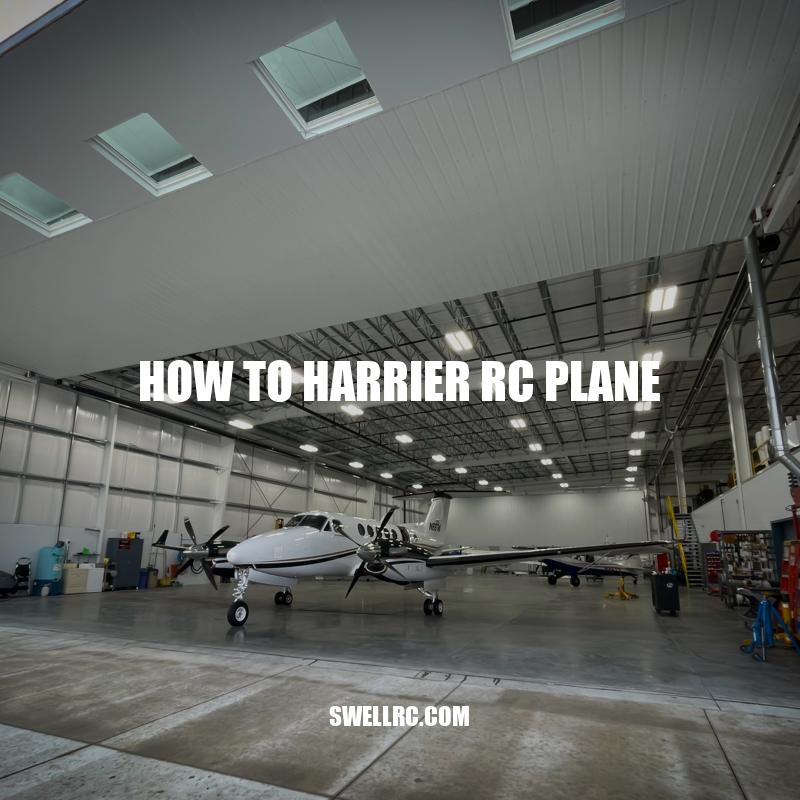How to Harrier an RC Plane: Tips for Beginner Pilots
RC planes are a popular pastime for many aviation enthusiasts. These miniature planes are replicas of full-scale planes but are controlled remotely, typically through a specialized remote control. One aspect of RC flying that has garnered significant attention among hobbyists is the act of ‘harrier flying.’ A harrier RC plane is a type of RC plane that can perform a unique flight maneuver by hovering in mid-air. This maneuver requires exceptional control skill and precision to execute correctly. Although it’s considered one of the more challenging maneuvers for RC flyers, harrier flying can be an exhilarating experience once mastered. In this guide, we will discuss the essential steps needed to fly a harrier RC plane successfully. From choosing the right type of RC plane to assembling it, preparing it for flight, taking off, and landing, we’ll cover everything you need to know to get started with harrier RC flying.
Understanding the Basic Flight Maneuvers
Before we dive into harrier flying, it’s essential to have a basic understanding of the maneuvers involved in RC flying. Here are the essential flight movements and how they affect the RC plane:
- Roll: The motion of the plane around its longitudinal (roll) axis.
- Pitch: The motion of the plane around its lateral (pitch) axis.
- Yaw: The motion of the plane around its vertical (yaw) axis.
To execute a harrier flight, you’ll need to be proficient in these movements and the physics of RC flying. Here’s what you need to know:
- Harrier flying requires precise control over throttle and elevator controls to achieve liftoff and maintain stable mid-air hovering.
- A harrier RC plane is designed differently from other RC planes and creates lift through its relatively large and sloping wing surface.
- It’s vital to master these movements before attempting to learn how to harrier an RC plane fully.
If you’re new to RC flying, it’s best to start with an RC plane that’s easy to fly and maneuver. Websites like RCGroups.com and RCUniverse.com offer resources and user forums where you can get advice on the best RC planes for beginners.
What are the aerodynamics of RC planes?
Some key factors that affect the aerodynamics of RC planes include:
- The shape and size of the plane’s wings, including the angle of attack and wing loading.
- The weight and balance of the plane, which affects its ability to maintain stable flight.
- The control surfaces on the plane, including the elevator, rudder, and ailerons.
- The power system, such as the motor, propeller, and battery, which affects the plane’s speed and lift.
To learn more about RC planes and their aerodynamics, check out websites and forums dedicated to the hobby, such as RCGroups.com and FliteTest.com. You can also find a variety of RC planes and related products on websites like HobbyKing.com and HorizonHobby.com.
Choosing the Right RC Plane
Choosing the right RC plane is crucial to master the art of harrier flying. Here are some factors to consider when selecting an RC plane:
- Type of plane: Choose an RC plane that’s specifically designed for harrier flying or has a high lift capability.
- Size and weight: The plane’s size and weight determine its stability, durability, and resistance to wind. Choose an RC plane that’s large enough to handle the powerful motor and durable enough to withstand crashes.
- Assembly time: Some RC planes come pre-assembled, while others require assembly. Choose an RC plane that suits your assembly skills and time available.
- Budget: Harrier RC planes come at various price ranges, with some affordable and others expensive. Decide on a budget and choose a quality RC plane that fits your budget.
Here’s a table comparing the popular RC planes suited for harrier flying:
| Brand | Model | Wingspan | Price |
|---|---|---|---|
| Horizon Hobby | UMX Yak 54 3D BNF | 16.3 in | $200 |
| E-flite | Extra 300 3D | 47.2 in | $270 |
| Dynam RC | Hawker Tempest 1250mm RTF | 49.2 in | $350 |
Choosing an RC plane suited for harrier flying is the first step towards mastering harrier flights. It’s essential to review the manufacturer’s specifications, user reviews, and forums to make an informed decision.
How do I choose the right motor for my RC plane?
- Determine the required power and speed of your RC plane. This will depend on the size and weight of the aircraft.
- Consider the type of flying you plan to do. Different types of motors are better suited for different types of flying, such as aerobatics, hovering, or long-distance flights.
- Choose the appropriate motor size and power source (electric or fuel-powered). Electric motors are becoming more popular for RC planes as they are cleaner and quieter than fuel-powered motors.
- Choose a reputable brand with good customer reviews and warranties.
- Consult online forums and RC plane communities for advice and recommendations on specific motors.
For further information and products, check out websites such as Motion RC, Horizon Hobby, or Tower Hobbies.
Assembling the RC Plane
Assembling an RC plane for harrier flying can seem daunting, but following the manufacturer’s instructions makes the process easy. Here are the essential steps to assemble an RC plane for harrier flying:
- Wing Attachment: Attach the wings to the fuselage by sliding them in the pre-cut wing slots and gluing them.
- Motor Installation: Install the motor on the engine mount and glue it to the fuselage using epoxy glue.
- Receiver Installation: Install the receiver onto the fuselage by using Velcro tape or servo tape. Connect the receiver to the motor, ESC, and servos.
- Servo Installation: Install the servos onto the wings using hot glue, then run the wiring into the fuselage.
- Battery Attachment: Attach the battery to the fuselage using a Velcro strap.
- Radio Setup: Program the radio to match the manufacturer’s instructions, set the endpoints, and adjust the dual rates.
It’s important to pay attention to each step to ensure the plane’s stability, durability, and correct operation. Additionally, assembling and setting up an RC plane for harrier flying can be time-consuming and requires a lot of patience. If you’re new to the hobby, it’s recommended to seek help from experienced pilots or online forums like RCGroups.com or RCUniverse.com to learn more.
How to make a RC plane at home?
Making a RC plane at home can be a fun and rewarding experience. Here are some basic steps to get you started:
- Choose a design and gather materials.
- Cut out the frame pieces and assemble them together.
- Attach the motor, propeller and control surfaces.
- Install the radio receiver and battery.
- Test the plane for proper balance and flight characteristics.
For more detailed instructions and tips, check out websites such as Flite Test and RC Groups. They offer a variety of resources, including tutorials, forums, and product reviews, to help you with your RC plane project.
Preparing for Flight
Before taking your harrier RC plane to the skies, it’s important to take some precautions to ensure your safety and the plane’s performance. Here’s what you need to do to prepare for flight:
- Check the battery: Make sure the battery is fully charged and in good condition.
- Check the radio equipment: Turn on the radio and ensure that everything is working as it should. Check the connection and make sure there are no loose parts.
- Check the wings: Inspect the wings for damages, such as cracks or imperfections. Check the servo linkages and make sure they are secure and tightened.
- Pick the right flying location: Find an open, flat space where you can take off and fly the harrier RC plane without any obstacles, people, or structures nearby.
- Test fly: Before attempting a harrier flight, do some basic test flights to ensure that everything is working properly.
By taking these steps, you can avoid unexpected issues and make sure that your harrier RC plane is ready to fly safely and securely. It’s also worth noting that you should always follow local and national regulations for RC aircraft flying. Check with the local authorities or nearby RC clubs for any specific rules or guidelines you should know about.
How do you fly a rolling Harrier?
To fly a rolling Harrier, follow these basic steps:
- Start by gaining enough altitude and airspeed.
- Pull back the elevator to maintain altitude while reducing the throttle to about 40% to 50%.
- Roll the plane about 45 degrees and start to input aileron and rudder control movements to maintain the roll along with the elevator to maintain altitude.
- Keep the Harrier rolling by controlling the throttle and adjusting the elevator, rudder, and ailerons as needed.
Remember, practice makes perfect! For more tips and tutorials on flying RC airplanes, check out websites such as RC Groups, Flite Test, or Horizon Hobby. They offer a wide range of resources for all skill levels, including instructional videos, forums, and product reviews.
Taking Off and Flying
Now that you’ve taken the necessary precautions and have completed a few basic test flights, it’s time to attempt the harrier flight. Here are some tips to help you achieve a successful takeoff and stable harrier flight:
- Gradually increase the throttle: Start the motor and gradually increase the throttle to achieve lift-off.
- Find the sweet spot: Once you’re airborne, find the right balance of throttle, pitch, and control to achieve a stable flight.
- Use small movements: Avoid making sudden or large movements, which can cause the RC plane to lose control or stability.
- Control the altitude: Use the throttle and pitch to control the altitude of the harrier RC plane but keep it steady.
- Consider the wind: Be mindful of the wind conditions, which can affect the flight of the RC plane.
- Practice: Like any skill, harrier flight requires practice. Keep at it, and with time, you’ll master the technique.
While harrier flight can be challenging, it’s also exciting and rewarding. Don’t be afraid of making mistakes, take your time, and enjoy the experience. For anyone who may want to learn more, there are many online resources and communities where you can share tips, get advice, and connect with other RC plane enthusiasts.
Can Harriers take off normally?
Yes, Harriers, also known as Varied Hawks, can take off normally. They have a unique way of taking off that involves running on the ground for several meters and then flapping their wings to lift off. They are fast and powerful flyers and are often spotted soaring high in the sky above open habitats.
For more information about Harriers and other birds of prey, visit the website of the National Audubon Society or the Cornell Lab of Ornithology.
Landing the RC Plane
Landing a harrier RC plane requires careful control and strategy. Here are some tips to help you master the landing process:
- Choose the right spot: Find a suitable location that is free from obstructions, wind, or any hazards.
- Reduce the throttle: Gradually reduce the throttle to decrease the speed of the RC plane.
- Gently descend: Use the pitch to gently descend until the RC plane is a few feet from the ground.
- Level out: Before the RC plane is about to touch the ground, level out the pitch to glide the RC plane smoothly.
- Control the speed: Control the speed of the RC plane by gradually reducing the throttle.
- Be patient: Take your time during the landing process, and if necessary, abort the attempt and try again.
Conclusion
Harrier flight is an engaging and entertaining hobby that requires focus, patience, and practice to master. By understanding the basics of flight maneuvers, choosing the right RC plane, assembling it correctly, preparing for flight, and following these takeoff, flight and landing tips, you can achieve successful harrier flight with your RC plane. Keep in mind that it can take time to become proficient in this skill, so don’t be discouraged if it doesn’t work the first time; keep practicing and seeking advice from other hobbyists through online resources, forums, or community groups. With time, patience and the willingness to learn, you’ll find this thrilling hobby to be one of the most rewarding you’ve ever experienced.



